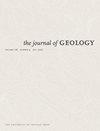澳大利亚新英格兰造山带南部麦夸里港地块俯冲浊积岩碎屑物来源——地球化学视角
IF 1.3
4区 地球科学
Q2 GEOLOGY
引用次数: 0
摘要
澳大利亚新英格兰奥罗根州南部的麦考瑞港出现了一个包含蓝片岩和榴辉岩、中奥陶世中洋脊玄武岩、燧石和碎屑沉积物的构造混杂体。碎屑岩贫石英,主要为镁铁质火山岩和碎裂斜长石碎屑;长英质火山碎屑不太常见。它们表现出侵蚀基底、分级层理、荷载结构和岩性,从层状泥岩到含砾砂岩。基于这些特征,它们被解释为浊积岩。在俯冲过程中,这些浊积岩在预混岩-泛辉橄榄岩和下绿片岩相条件下发生变形和变质。在地球化学上,它们具有钙碱性的洋内弧特征;显示没有回收;来源于玄武岩安山岩成分的镁铁质火山岩。此外,化学蚀变指数(44–69)和成分变异指数(0.8–2.4)数据显示,它们几乎没有风化作用,而且不成熟。在存在热带气候条件的地方,岩石没有风化,这是由于与动态环境相关的极端侵蚀,导致沉积物快速输送到弧前盆地,然后输送到海沟。因此,几乎没有时间进行风化。浊积岩中的碎屑被认为来源于Murrawong组Macquarie弧和弧前盆地序列中的晚奥陶世火山岩。与它们相关的燧石记录了大陆和洋弧的地球化学特征。本文章由计算机程序翻译,如有差异,请以英文原文为准。
Source of Detritus in Subducted Turbidites, Tectonic Mélange, Port Macquarie Block, Southern New England Orogen, Australia—A Geochemical Perspective
A tectonic mélange containing blueschists and eclogites, Middle Ordovician mid-ocean ridge basalt, cherts, and clastic sediments occurs at Port Macquarie in the southern New England Orogen, Australia. The clastics are quartz-poor and are dominated by mafic volcanic and fragmented plagioclase clasts; felsic volcanic clasts are less common. They exhibit erosional bases, graded bedding, load structures, and lithologies ranging from laminated mudstones to pebbly sandstones. Based on these features, they are interpreted as turbidites. During subduction, these turbidites were deformed and metamorphosed under prehnite–pumpellyite and lower greenschist facies conditions. Geochemically, they have a calc-alkaline, intra-oceanic arc signature; show no recycling; and have been derived from a provenance dominated by mafic volcanic rocks of basaltic-andesite composition. Further, chemical index of alteration (44–69) and Index of Compositional Variability (0.8–2.4) data reveal they show little weathering and are immature. The lack of weathering of rocks in a location where tropical climatic conditions existed is attributed to extreme erosion associated with a dynamic setting resulting in rapid transportation of the sediments to the fore arc basin and subsequently to the trench. As a consequence, little time was available for weathering to take place. The detritus in the turbidites is thought to have been derived from Late Ordovician volcanics in the Macquarie Arc and fore arc basin sequences of the Murrawong Formation. The cherts with which they are associated record both a continental and oceanic arc geochemical signature.
求助全文
通过发布文献求助,成功后即可免费获取论文全文。
去求助
来源期刊

Journal of Geology
地学-地质学
CiteScore
3.50
自引率
5.60%
发文量
0
审稿时长
3 months
期刊介绍:
One of the oldest journals in geology, The Journal of Geology has since 1893 promoted the systematic philosophical and fundamental study of geology.
The Journal publishes original research across a broad range of subfields in geology, including geophysics, geochemistry, sedimentology, geomorphology, petrology, plate tectonics, volcanology, structural geology, mineralogy, and planetary sciences. Many of its articles have wide appeal for geologists, present research of topical relevance, and offer new geological insights through the application of innovative approaches and methods.
 求助内容:
求助内容: 应助结果提醒方式:
应助结果提醒方式:


